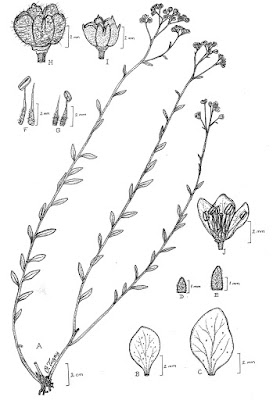Abstract
A new species of Haplophyllum, Haplophyllum ermenekense (Rutaceae) is described and illustrated in line drawing. It grows on stony slopes of Ermenek town, Karaman province, in southern Turkey. It is compared with the closely related species H. myrtifolium. H. ermenekense is distinguished from the morphologically similar H. myrtifolium chiefly by sepal shape, petal size, capsule size, presence of capsule hair and appendage form. On the other hand, the seed coat and pollen grains surface of H. ermenekense and H. myrtifolium are demonstrated in SEM photographs. In addition to the detailed description, the illustration, distribution map, conservation status and ecology of the new species are also provided.
Keywords: Endemic, Haplophyllum, Karaman, Rutaceae, taxonomy
 |
| Figure 3. General view of habit and flowers: A, B Haplophyllum ermenekense C, D H. myrtifolium. |
Haplophyllum ermenekense Ulukuş & Tugay, sp. nov.
Diagnosis: Haplophyllum ermenekense most resembles the closely related H. myrtifolium. It differs from H. myrtifolium by its inflorescence usually lax form (versus dense), sepals ovate or ovate-oblong (versus lanceolate or lanceolate-oblong) and deciduous in fruit (versus persistent in fruit), petals 4–5.5 × 1.5–2.5 mm (versus 6.5–9.5 × 3.5–4.5 mm), capsule 2–2.5 × 3–4 mm (versus 3–3.5 × 5–6 mm) and glabrous (in contrast to not glabrous), with a conspicuous usually erect appendage on the outer upper surface (versus incurved appendage on the outer upper portion).
Etymology: The name of Ermenek town where new species found is given to the species epithet.
Proposed Turkish name for the new species: Ermenek sedosu.
Ecology: Haplophyllum ermenekense is endemic to Turkey. It grows at altitudes between 980 and 1200 m on limestone slopes amongst bushes (e.g. Quercus coccifera L., Juniperus oxycedrus L., Pistacia terrebinthus M.Bieb. etc.). Plant diversity in this place is mainly composed of herbaceous and suffruticose plants including Adonis flammea Jacq., Aegilops cylindrica Host, Aethionema stylosum DC., Capsella bursa-pastoris (L.) Medik., Centaurea virgata Lam., Digitalis cariensis Boiss. ex Jaub. & Spach, Ebenus plumosa Boiss. & Bal. subsp. speciosa Boiss.& Bal., Glaucium corniculatum (L.) Rud. subsp. corniculatum, Glaucium leiocarpum Boiss., Hyoscyamus aureus L., Hyoscyamus niger L., Isatis ermenekense Yıld., Micromeria cristata (Hampe) Griseb. subsp. cristata, Salvia albimaculata Hedge & Hub-Mor. and Salvia aucheri Bentham var. canescens Boiss. & Heldr.
Distribution and conservation status: Haplophyllum ermenekense is endemic to Karaman province. It is an element belonging to the east Mediterranean phytogeographic region (Fig. 1). The range of this new species is limited to a single locality and its area of occupancy is estimated to be less than 5 km or 5 km2. The number of mature individual plants is estimated to be less than 250. As it is perennial, this new species has a crucial advantage for its future as destruction of the bushes by local people, road construction and deterioration of habitats may cause some threats. Thus, according to criterion D, it can be included in the EN (Endangered) category (IUCN 2001; 2016).
Deniz Ulukuş and Osman Tugay. 2018. Haplophyllum ermenekense (Rutaceae), A New Species from Turkey. PhytoKeys. 111: 119-131. DOI: 10.3897/phytokeys.111.24241




